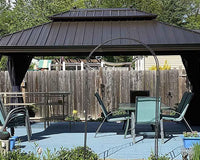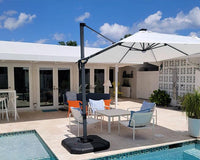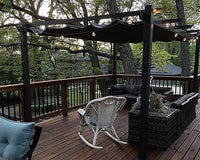Creating a cozy alfresco dining space is all about selecting the right furniture that not only looks great but can also handle whatever Mother Nature throws its way. Metal and wood are two of the most popular materials for outdoor dining sets. Each has its own unique appeal and practical considerations. Let us now explore what makes each material unique.
The Timeless Appeal of Wood Dining Sets
There's simply something inherently inviting about a wooden outdoor dining set. It brings warmth and classic sophistication to any patio or deck.

What Kinds of Wood Are We Talking About?
Not all woods are created equal for outdoor use.
- Teak: Often the gold standard for outdoor wood furniture. It's naturally high in oils, which makes it highly durable in withstanding rot, insects, and water damage. Teak ages beautifully to a silvery-gray patina or can be oiled periodically to maintain its golden hue. It's also one of the most expensive.
- Acacia, Eucalyptus, Shorea: These are a few other durable hardwoods with fine weather resistance, often at a lower cost than teak. They typically must be sealed or oiled periodically to maintain appearance and durability.
- Cedar and Redwood: These softwoods are also resistant to rot and insects, but softer and more prone to dents and scratches than hardwoods. They are lightweight and generally have a rustic appeal.
- Pine or Fir (Pressure-Treated): These are generally the most budget-friendly woods, but they require frequent sealing and painting to protect them from the weather and will generally not survive outdoors as long as hardwoods.
The Reason Of People Love Wood Dining Sets
Wood just feels good. It has a tactile warmth, stays cooler to the touch in direct sun compared to some metals, and offers a huge range of styles from rustic farmhouse to sleek modern. Plus, many types of wood can be refinished or repaired if they get damaged, potentially extending their life.

The Sleek Durability of Metal Dining Sets
Metal outdoor dining sets offer a different kind of appeal, often leaning towards durability, lower maintenance, and a wider array of contemporary and traditional designs.
Common Metal Choices for Outdoor Furniture
- Aluminum: This is a very popular choice because it's lightweight, rust-proof, and relatively affordable. Aluminum frames can be cast into intricate designs or have clean, modern lines. Powder-coated finishes add color and extra protection.
- Wrought Iron: Known for its heft and classic, ornate look, wrought iron is incredibly strong and durable. It's very heavy, which is great in windy areas, but it can rust if the protective finish is compromised, so it needs occasional touch-ups.
- Steel (Stainless or Powder-Coated): Steel offers strength, and stainless steel provides excellent rust resistance (though it's usually pricier). Regular steel needs a good powder-coated finish to prevent rust when used outdoors.
Why Metal Might Be Your Pick
Metal sets, particularly aluminum, are often praised for being low-maintenance. They generally just need a wipe-down. They can also offer very slim profiles, which can be great for smaller patios. The design possibilities with metal are vast, from ultra-modern minimalist to elaborate traditional scrollwork.

| Feature | Wood | Metal |
|---|---|---|
| Durability & Weather Resistance |
|
|
| Maintenance Requirements | Higher maintenance. Requires periodic cleaning, sanding, and sealing to preserve look and integrity. | Much lower maintenance. Mostly requires simple cleaning. Occasional paint touch-ups for iron/steel. |
| Comfort & Temperature | Stays at a more neutral temperature. Feels naturally comfortable to the touch. | Can get very hot in the sun and cold in cool weather. Cushions are highly recommended. |
| Weight & Stability | Varies from heavy (hardwoods) to light (softwoods). Generally very stable. |
Wrought Iron: Very heavy and stable. Aluminum: Lightweight and easy to move. |
| Aesthetics & Style | Natural, organic, warm look. Ideal for traditional or rustic styles. | Versatile. From ornate (wrought iron) to sleek and modern (aluminum). |
| Cost Factor | Wide range. From budget-friendly pine to premium teak. | Wide range. From affordable steel to mid-range aluminum and high-end iron. |
Key Comparison Points: Wood vs. Metal
Let's put them head-to-head on some important factors:
Durability and Weather Resistance
High-quality hardwoods like teak are exceptionally durable. Other woods require more diligent sealing and protection to prevent rot, warping, or insect damage. Wood is susceptible to sun fading over time.
Aluminum is rust-proof. Wrought iron and steel can rust if their protective coatings are chipped or scratched, requiring touch-ups. Metal generally handles moisture better than unprotected wood.
Maintenance Requirements
Most woods need regular cleaning (except perhaps teak left to weather naturally), and periodic sanding, staining, sealing, or oiling to maintain their appearance and protect them from the elements. This can be an annual or biennial task.
Metal needs much lower maintenance. Aluminum usually just needs cleaning with soap and water. Wrought iron or steel might need occasional paint touch-ups if rust appears.

Comfort and Temperature
- Wood: Tends to stay cooler to the touch in direct sun and warmer in cool weather compared to metal. It has a naturally comfortable feel.
- Metal: Can get very hot in direct summer sun and quite cold in cooler temperatures. Cushions are almost always a must for comfort with metal seating.
Weight and Stability
- Wood: Hardwoods like teak can be quite heavy and stable. Softer woods are lighter.
- Metal: Wrought iron gazebo is very heavy and won't blow around. Aluminum is very lightweight, which is easy to move but might be a concern in very windy areas unless the design is substantial and weighted or use anchoring techniques.
Aesthetics and Style
- Wood: Offers a natural, organic, and often traditional or rustic look. It can bring a sense of warmth and coziness.
- Metal: Can range from classic and ornate (wrought iron) to sleek, industrial, or minimalist (aluminum, steel). Often lends itself well to modern and contemporary designs.
Cost Factor
- Wood: Prices vary hugely. Pressure-treated pine is budget-friendly. Cedar and acacia are mid-range. Teak is a premium investment.
- Metal: Basic powder-coated steel can be affordable. Aluminum is often mid-range. Ornate wrought iron or high-end designer stainless steel sets can be quite expensive.
Wood vs. Metal Outdoor Dining Sets: How to Choose
There's no single "best" material; it truly depends on your specific needs, climate, budget, and how much time you're willing to dedicate to maintenance.

Consider Wood Outdoor Dining Sets If:
- You love a natural, warm aesthetic.
- You don't mind (or even enjoy) a bit of seasonal maintenance.
- You live in a climate where wood performs reasonably well (and you choose an appropriate wood type).
- Wood dining sets in moderate temperatures is a priority.
Consider Metal Outdoor Dining Sets If:
- Low maintenance is a top priority for you.
- You prefer a modern, industrial, or classic ornate style.
- You live in a very damp climate where wood might struggle without constant care.
- You plan to always use cushions for comfort.
- You need something very lightweight (aluminum) or heavy dining sets to resist wind (wrought iron).
Ultimately, the best outdoor dining set is one that you'll enjoy using for many seasons. Think about how you live, the look you want to achieve, and the level of upkeep you're prepared for. Both wood and metal can create beautiful and functional outdoor dining experiences when you choose wisely.




